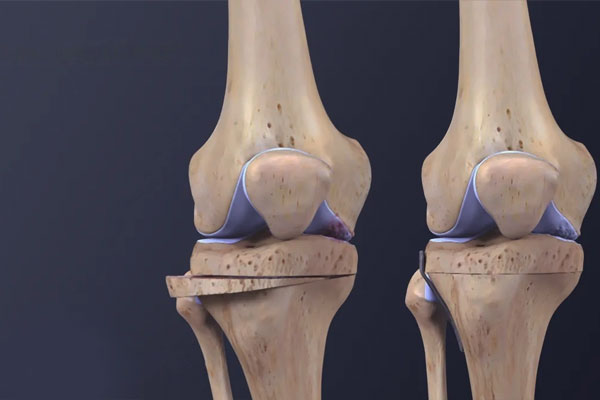Osteotomy of the Knee
Arthritis in any part of the knee joint will result in damage to the articular cartilage (the cartilage in the joint). When this cartilage tears away, it will expose the bone surfaces. Thus, the affected limb will not move so freely and easily. If the cartilage tears occur on both sides of the knee, then the space between these bones will reduce symmetrically. In some cases, like early-stage osteoarthritis, there will be cartilage damage on only one side of the knee joint, and the knee will begin to bend due to asymmetric joint space narrowing. To relieve the symptoms of arthritis and realign the leg, a surgeon may recommend a correction surgery known as an osteotomy of the knee.

What is a knee osteotomy?
A knee osteotomy is a surgical procedure that involves making a cut in any one of the bones in your lower leg in order to correct the knee's alignment and improve its function.
The two most common types of knee osteotomies are high tibial osteotomies and femoral osteotomies. During knee osteotomies, the bones in the tibia (shin bone) or femur (thigh bone) are cut, reshaped, and realigned. This will shift your body weight from the damaged part of your knee to the healthy part.
When is knee osteotomy recommended?
Knee osteotomy is usually recommended for patients with early-stage osteoarthritis that has damaged one side of the knee joint and for young osteoarthritis patients (age less than 60) who are not considered for total knee replacement surgery. The best candidates for the surgery are those who:
- Have a healthy weight.
- Have good knee stability.
- Physically active.
- I have moderate arthritis with significant knee pain.
- Are relatively young.
What are the pre-procedure care for the surgery?
Your surgeon will take X-rays of your knee to plan the surgery and determine how much correction of the deformity is needed. Before undergoing the surgical procedure, you have to follow certain instructions given by your healthcare provider. These include:
- Stop taking some medications temporarily for at least one week prior to the procedure.
- Do not eat or drink anything after midnight on the day of your procedure.
- Arrange for someone to drive you home and assist you after surgery.
- Stop smoking and drinking, as it may prolong the recovery time after the surgery.
How is knee osteotomy performed?
Most knee osteotomy procedures are performed by the following two methods:
- Opening wedge: The surgeon will cut open a section of bone, and a bone graft is inserted to fill the gap. The graft is fixed in place using metal plates and screws.
- Closing wedge: The surgeon cuts and removes a wedge-shaped bone from the knee joint, and the resulting gap is closed by bringing the cut edges of the opening together.
For the knee osteotomy surgery, you will be admitted to the hospital on the day of the surgery. Once you are admitted to the hospital, a doctor from the anesthesia team will evaluate you and finalize the type of anesthesia for the procedure. For knee osteotomies, either general (putting you to sleep) or spinal (numbing your body from the waist down) anesthesia can be used. The procedure for the surgery is as follows: The surgery is performed as follows:
- Before the procedure, you will be administered anesthesia along with an antibiotic to prevent infection.
- A surgeon will make an incision at the front of your knee, starting below your kneecap.
- Your shinbone or thighbone may be involved in the procedure, depending on where the damage is.
- For the open wedge method, a surgeon will cut a wedge-shaped bone in the painful side of the knee, and a bone graft is placed to fill the gap. The graft is fixed in place with a plate and screws.
- For the closed wedge method, the surgeon will cut and remove a wedge-shaped bone, and the resulting gap is closed by bringing the cut edges together and securing them with a plate and screws.
What is the post-procedure care?
You will require a few days of hospitalization after the procedure. There will be a prescription for drugs to treat infections and discomfort. You will likely use walking aids like crutches or a walker for several weeks to avoid putting too much weight on the knee until it heals. A physiotherapist will provide instructions about leg exercises to strengthen the muscles and assist you in using crutches to walk.
Once you are comfortable and can walk using crutches, the surgeon will allow you to be discharged. It can take up to six months to return to normal life after a knee osteotomy. It is important to perform exercises regularly at home to optimize the outcome of the surgery.
Outlook
Knee osteotomies relieve arthritis pain and will delay the need for a total knee replacement by 10 to 15 years for arthritic patients. Knee osteotomy is a highly successful treatment procedure that provides good function and corrects poor knee alignment. Furthermore, knee osteotomies allow patients to return to high-impact activities, such as jogging or playing basketball, which is not the case after total knee replacements.